Pre-Dawn Planet Action, the Full Moon Passes Bees, Covers Stars, and Shows Rays, and Spring Begins!
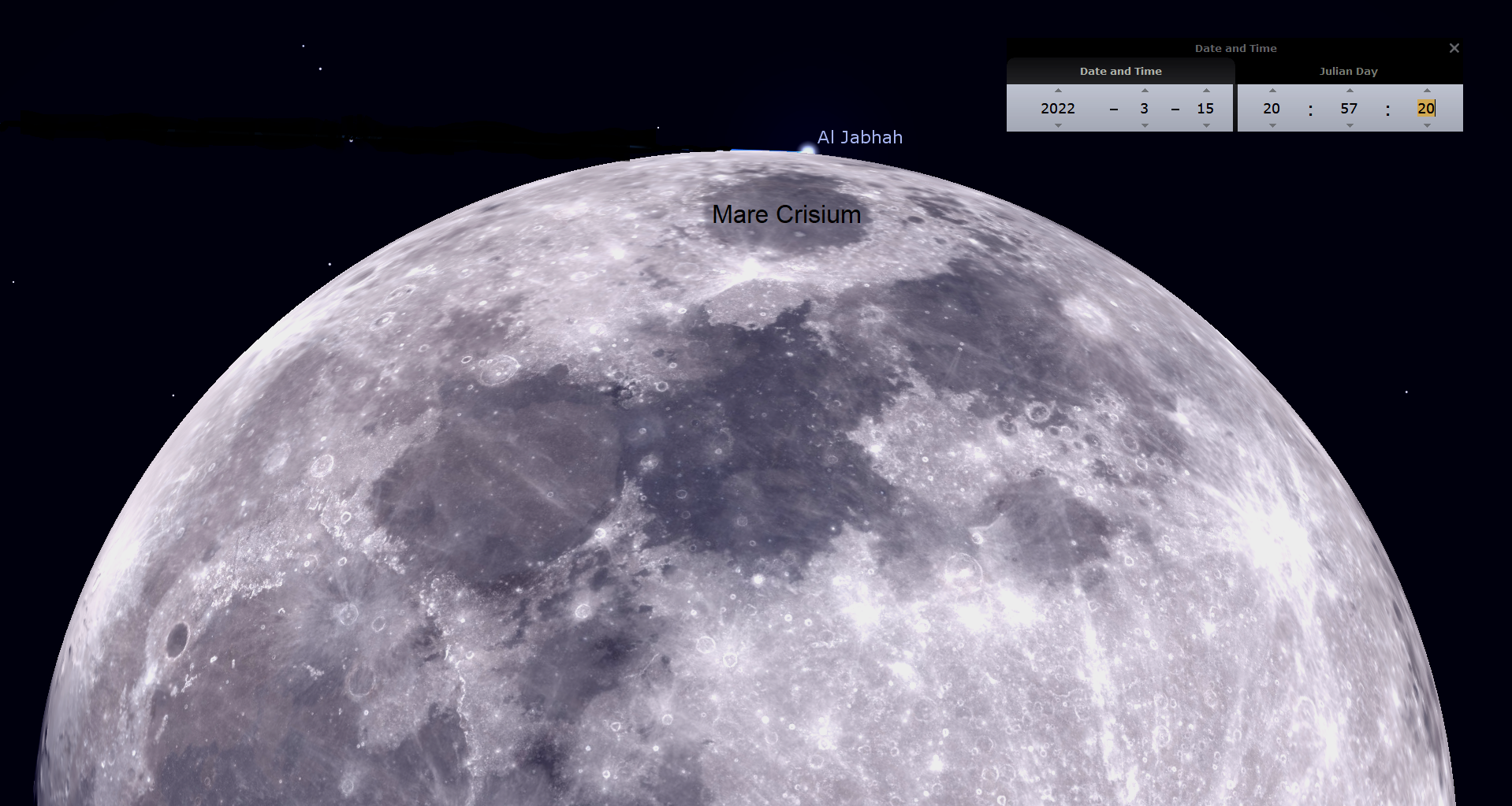
On the early evening of Tuesday, March 15, 2022, the nearly full moon will occult the bright star Algieba in Leo. times vary by location. This scene shows the end of the event at 8:57 pm EDT, after the star has emerged near Mare Crisium.
Hello, mid-March Stargazers!
Here are your Astronomy Skylights for the week of March 13th, 2022 by Chris Vaughan. Feel free to pass this along to your friends and send me your comments, questions, and suggested topics. You can also follow me on Twitter as @astrogeoguy! Unless otherwise noted, all times are expressed in Eastern Time. To subscribe to these emails please click this MailChimp link.
If you’d like me to bring my Digital Starlab portable inflatable planetarium to your school or other daytime or evening event, or deliver a session online, contact me through AstroGeo.ca, and we’ll tour the Universe, or the Earth’s interior, together! My terrific new book with John A. Read entitled 110 Things to See With a Telescope is a guide to viewing the deep sky objects in the Messier List – for both beginners and seasoned astronomers. DM me to order a signed copy!
The bright moon will dominate the night sky this week around the world as it waxes through the March full moon. Meanwhile, it will occult several bright stars and exhibit bright ray systems. Three bright planets will continue to dance in the eastern pre-dawn sky, and on Sunday the sun will step across the celestial equator to commence spring in the Northern Hemisphere. Read on for your Skylights!
Daylight Saving Time
Have you changed your clocks? If you missed last week’s note about Daylight Saving Time, I posted it here.
The Moon and the Beehive
During this week, skywatchers worldwide will have night skies that are flooded with bright moonlight. Our natural nightlight will be more than 80% illuminated all week – waxing to full on Friday morning, and then starting its waning period on the coming weekend. So, let’s make lunar lemonade and appreciate its events and features!
Tonight (Sunday), the waxing gibbous moon will shine brightly within the confines of Cancer (the Crab), but that constellation’s modest stars will not be visible against the moon’s glare unless you hunt for them in binoculars. Speaking of which, the moon’s slow orbital motion tonight (it shifts eastward by its own diameter each hour) will carry it past the large open star cluster in Cancer known as the Beehive, Praesepe ”Latin for manger”, and Messier 44. Once the sky becomes fully dark, after 8:30 pm local time, the cluster, which is double the diameter of the moon, will be positioned a palm’s width below (or 6° to the celestial southeast of) the moon. By midnight and beyond, the moon’s motion, plus the diurnal rotation of the sky, will carry the moon closer to the cluster and swing the moon lower, to the cluster’s right. The moon and the cluster will be close enough to share the field of binoculars, but you’ll see more of the “bees” if you tuck the moon just out of sight on the upper right of your field of view.
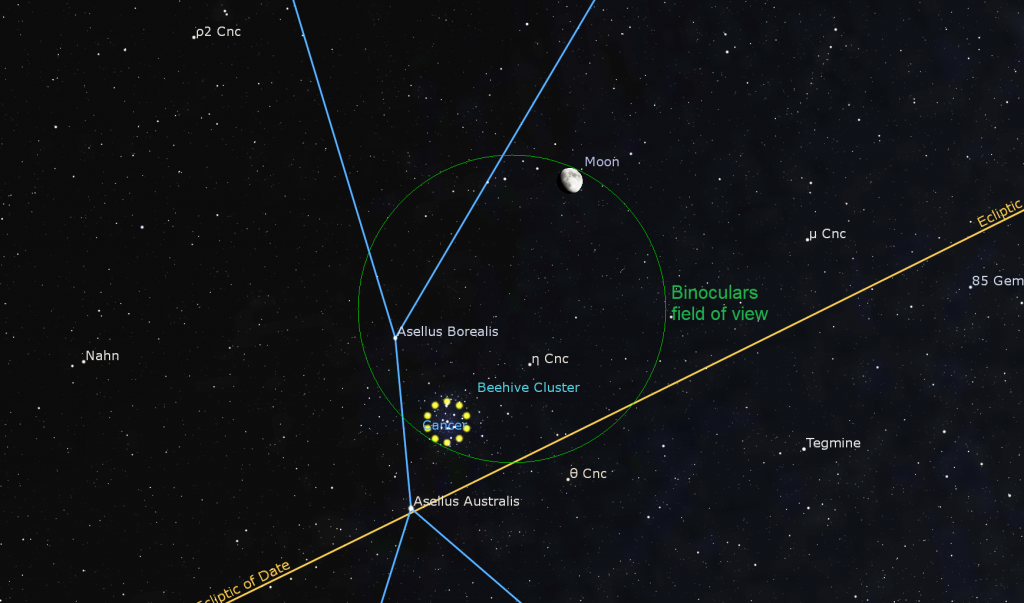
Because the Beehive is located only a thumb’s width north of the ecliptic, the moon and planets “visit for honey” quite frequently! The moon passes the cluster every 27 days. It usually swings rather wide of Messier 44, but it can also pass through it. Their best meetings occur in May and June, when the cluster is in the western post-sunset sky, and the moon sports a less-bright, crescent phase. The same thing happens during September in the eastern pre-dawn sky. The planets visit the Beehive much less often. Mercury and Venus will each skim through the cluster’s outer edges on July 22 and August 17, respectively. Mars will pass directly through it on the evening of June 2, 2023!
The sun’s trip along the ecliptic brings it to Messier 44’s right ascension sky coordinate on July 30 every year. That summertime solar conjunction date means that the cluster is farthest from the sun in late January. If you do view the Beehive in late evening this week, note just how high in the sky it sits. The sun will be just as high around midday in a few months!
More Moon Doings
Tonight (Sunday), the pole-to-pole terminator that divides the moon’s lit and dark hemispheres will fall just to the left (or lunar west) of Sinus Iridum, the Bay of Rainbows. The circular, 249 km diameter feature is a large impact crater that was partly flooded by the same basalts that filled the much larger Mare Imbrium to its right (lunar east). The resulting “Golden Handle Effect”, which will be visible on Monday night, too, is produced when slanted sunlight brightens the eastern (right-hand) side of the prominent, curved Montes Jura, the old crater rim that surrounds the bay on the top and left (north and west). The Jura Mountains extend into Mare Imbrium as a pair of protruding promontories named Heraclides and Laplace at the bottom and top, respectively. You can see Sinus Iridum with sharp eyes – and easily in binoculars and backyard telescopes. It is almost smooth and craterless, but hosts a set of northeast-oriented dorsae or “wrinkle ridges” that are revealed under magnification at this phase.
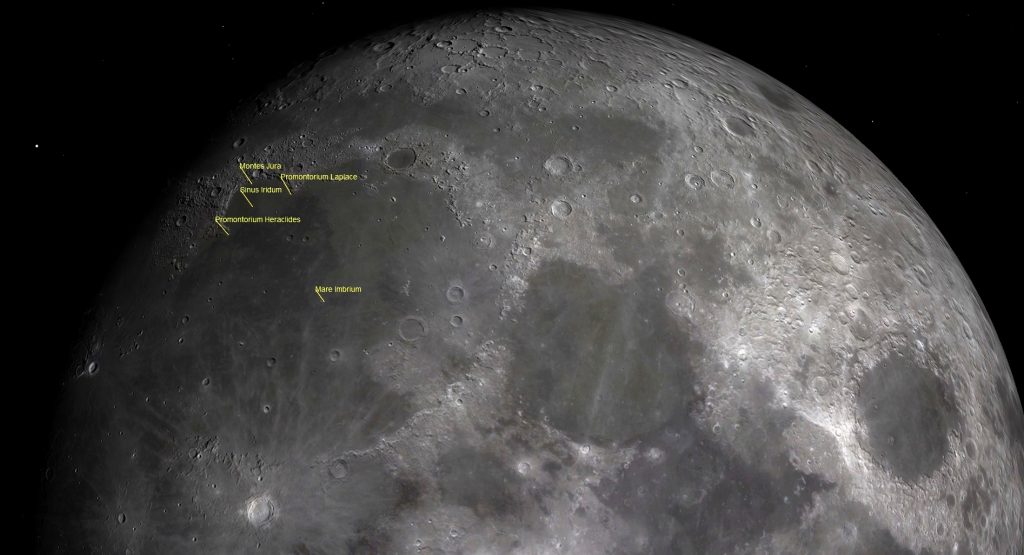
The moon will cross the border into Leo (the Lion) for Tuesday and Wednesday. On Tuesday evening, observers in eastern North America and northwestern Africa can see the nearly full moon cross in front of, or occult, Leo’s bright, magnitude 3.45 star named Eta Leonis (or Algieba or Al Jabhah). Surrounding regions will see the moon only pass very close to the star. Lunar occultations of bright stars can be safely watched through backyard telescopes and binoculars. The start and end times for this event vary by location. Use an astronomy app like Stellarium to look up the times for your site.
In Toronto, the darkened, leading edge of the moon will cover Algieba at 7:47 pm EDT or 23:47 Greenwich Mean Time, but the sky won’t be very dark yet. Observers in Montreal (where the event will start at 7:56 pm), and longitudes east of there, will have darker skies. Algieba will pop out from behind the bright, trailing edge of the moon, near dark, round Mare Crisium, at 8:57 pm EDT (or 00:57 GMT on March 16). For best results, start watching several minutes ahead of each of the times quoted. If you have a smartphone adapter, or a steady hand, try to record a video!
From Thursday to Sunday, the moon will journey through the lengthy constellation of Virgo (the Maiden). On Thursday evening, observers in Mexico and the Caribbean can watch the almost full moon occult another bright star named Nu Virginis (or ν Vir) between about 7:25 and 8:30 pm EDT. In some locations the event will start before moonrise, but the star’s emergence will be visible.
The March full moon will occur on Friday morning, March 18 at 3:18 am EDT (or 07:18 GMT), causing it to appear not quite full in the Americas on both Thursday night and Friday night. Every culture around the world has developed its own set of stories for the moon, and every month’s full moon nowadays has one or more nick-names. The indigenous Ojibwe people of the Great Lakes region call the March full moon Ziissbaakdoke-giizis “Sugar Moon” or Onaabani-giizis, the “Hard Crust on the Snow Moon”. For them it signifies a time to balance their lives and to celebrate the new year. The Cree of North America call it Mikisiwipisim, the “the Eagle Moon” – the month when the eagle returns. The Cherokee call it Anvyi, the “Windy Moon”, when the planting cycle begins anew. The March full moon is also known as the Worm Moon, Crow Moon, Sap Moon or Lenten Moon. It always shines in or near the stars of Leo (the Lion) or Virgo (the Maiden). Holi, the Hindu festival of colours, will be celebrated on Friday’s full moon.
Full moons are, by definition, always opposite to the sun in the sky – so they rise in the east as the sun sets, and set in the west at sunrise. Since moon phases occur independently of Earth’s rotation, only observers in the Hawaii region will see this full moon rising at sunset. When fully illuminated, no shadows are cast by terrain – so the moon’s geology is enhanced, especially the contrast between the bright and ancient heavily cratered highlands and the younger, smoother, dark maria.
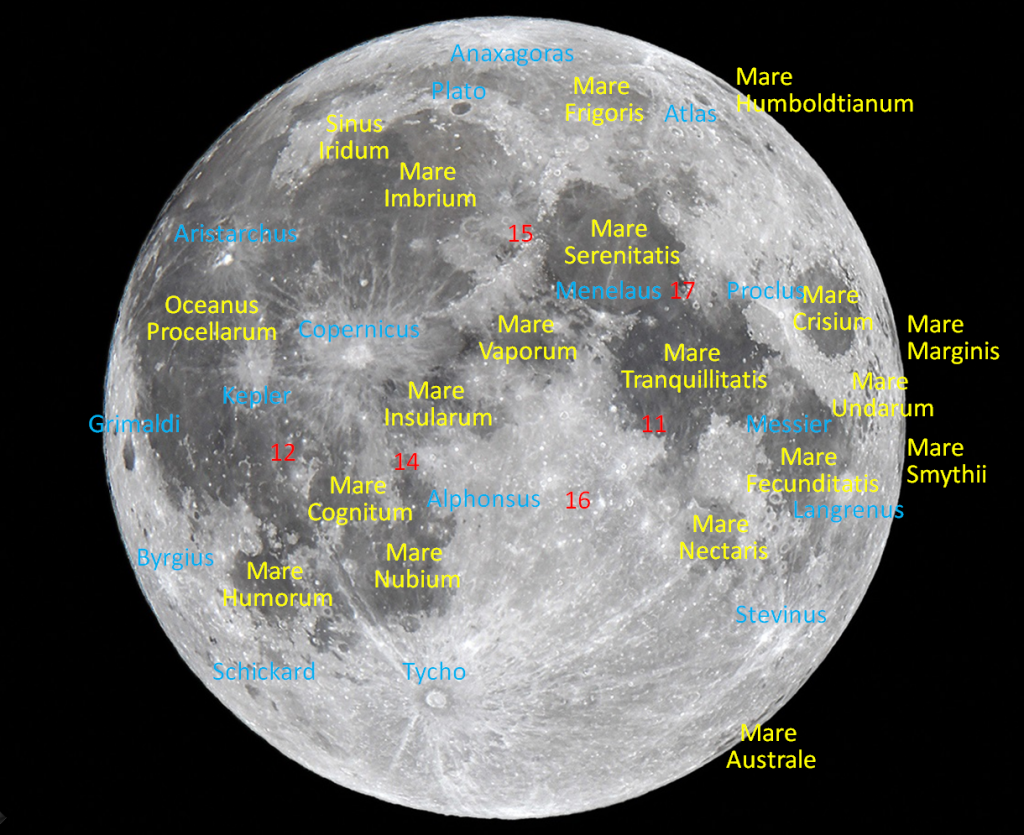
Grab your binoculars and look for the many ray systems sprayed across the full moon’s face. The rays are straight lines composed of material that has been thrown radially outwards when objects that slammed into the moon created its craters. The rays are particularly apparent when the moon is lit face-on, as it is around the full phase. Viewed in a telescope, major rays can be shown to be chains of small secondary impact craters excavated by the falling chunks of excavated rock (or ejecta), and by scattered debris itself. Impacts on the light-coloured lunar highland rocks tended to spread white rays over the surrounding darker mare regions – but sometimes the inverse happens.
Some ray systems are enormous – spanning half the moon’s disk! The ray system of the crater Tycho is a fine example. Tycho is the very bright crater located in the south central part of the moon. Its rays are largely missing on the left-hand (lunar western) side, suggesting that its impactor, an asteroid 8 to 10 km in diameter, arrived from the west at an angle less than 45° above the lunar surface, throwing the ejecta in front of it, mainly to the east. In a telescope, you can see that Tycho is encircled by an asymmetrical dark blanket of rubble that is about as wide as the crater’s 85 km diameter. The dark colour is probably basaltic rock excavated from deep below the crust. Tycho and its rays are bright because it is a relatively young crater – only about 109 million years old. The dinosaurs were walking the Earth when the violent event happened! It’s too bad they couldn’t tell us what they saw!
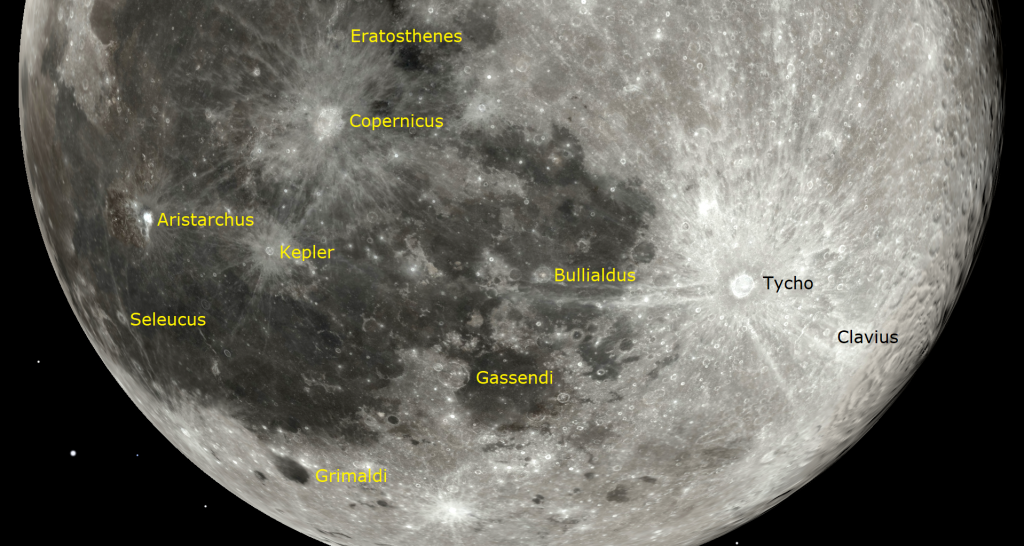
The small crater Proclus is located at the lower left edge of Mare Crisium, the round grey basin near the moon’s upper right edge (northeast on the moon). Proclus’ bright rays only extend toward the right-hand side of the crater, mainly onto Crisium. Look for symmetrical, but ragged ray systems around the big craters Copernicus and Kepler in Oceanus Procellarum, which covers the moon’s left-hand (western) side.
On Friday evening in the Americas, the full moon will be approaching from above (celestial west), the bright, magnitude 3.4 double star named Gamma Virginis or Porrima. In the wee hours of Saturday, observers in northeastern North America and the North Atlantic can see the moon occult that star. Surrounding regions will see the moon pass very close to the star. Porrima will be obscured for a longer time if the centre of the moon’s disk passes in front of it at your location – and for shorter a period if only the northern or southern edge of the moon occults the star.
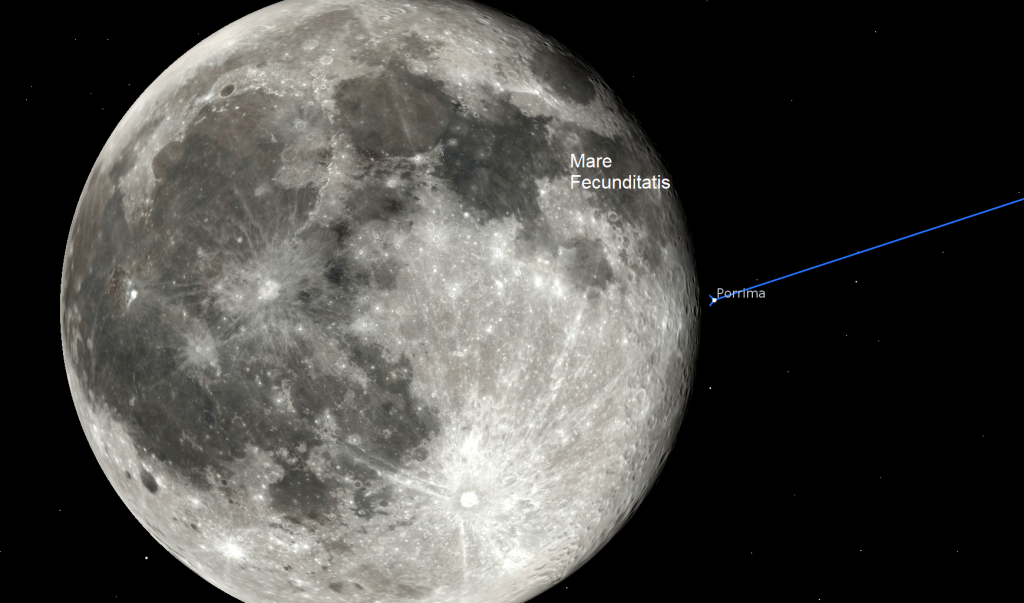
In the Greater Toronto area, the lit edge of the moon will cover each of Porrima’s close-together stars in rapid succession at 12:42 am EDT or 04:42 GMT. They’ll reappear almost simultaneously from behind the dark limb of the moon, well south of Mare Fecunditatis, at 1:33 am EDT or 05:33 GMT. In Halifax, Nova Scotia, where a greater diameter of the moon will cover them, the two stars will disappear at 1:52 am EDT and re-appear alongside Mare Fecunditatis at 3:05 am EDT. For best results, start watching several minutes ahead of each of the times quoted.
The Planets
Uranus is the only planet left in the evening sky – but its viewing window is nearly gone. Once the sky fully darkens, after about 8:30 pm local time, the magnitude +5.8 planet will be visible in the western sky in binoculars and backyard telescopes. The planet’s small, blue-green dot will be positioned a fist’s width to the left of (or 11 degrees to the celestial southeast of) Aries’ brightest stars, Hamal and Sheratan. In fact, it’s almost exactly midway along a line connecting Hamal with the bright star Menkar in Cetus (the Whale), and a little higher. After dusk, those stars will sit a third of the way up the west-southwestern sky. After 9 pm local time, Uranus will be getting a bit too low for decent views. Watch Uranus travel less than a finger’s width to the right (or 0.25° to the celestial north) of a medium-bright, close-together double star named Struve 287 (or HIP 12349) this week.

The bright planets fun is in the eastern pre-dawn sky, where Venus, Mars, and Saturn are gathered together already, and Jupiter will join them starting next week! If you have clear skies toward the southeast and an unobstructed view in that direction, head outside before sunrise to enjoy the show.

Extremely bright Venus will rise first, at about 5:30 am local time and then stay visible in the lower part of the sky until sunrise. Unlike airplanes, Venus won’t blink or flash, or move around. The 250 times fainter dot of reddish Mars will rise about 15 minutes later, and shine a few finger widths to Venus’ lower right (or celestial south). Mars will become hidden by the brightening sky before very long, so view it before 7 am local time. In a telescope Venus will exhibit a half-illuminated, waxing crescent phase, while Mars will show a tiny full disk. Good binoculars can also reveal Venus’ shape. (Be sure to turn all optics away from the eastern horizon before the sun rises.)
Venus and Mars have been travelling eastward together on parallel tracks. On Wednesday, the two planets will reach their minimum separation of 3.9 degrees – making a nice photo opportunity. That’s more than close enough for them to share the field of view in binoculars. The two planets will be nearly as close on the surrounding mornings. On Sunday, March 20, Venus will reach peak visibility at a maximum angle of 46.5° west of the sun. After the weekend, Venus’ swing sunward will steadily increase its separation from Mars.

Meanwhile, the yellowish dot of Saturn will be slowly pulling away from the sun and rapidly heading toward Venus and Mars. This week, Saturn will rise after 6 am local time. On Monday morning its general location will be 1.3 fist diameters to the lower left of Venus and Mars (or 13.5 degrees to the celestial east). That gap will shrink to 9 degrees on the weekend. Observers at the latitudes of Florida, Hawaii, Mumbai, and farther south will spot Saturn more easily.
Happy March Equinox!
On Sunday, March 20 at 10:33 am EDT (or 9:37 GMT), spring will officially arrive in the Northern Hemisphere! At that moment, the sun’s apparent motion eastward along the ecliptic will carry it cross the celestial equator and into the northern sky. (Of course, the sun isn’t moving – we are!) The astronomical term for this event is the Vernal Equinox, where “vernal” is Latin for “spring”. I prefer to say March Equinox because autumn will commence for everyone in the Southern Hemisphere on that same day. The hemispheres will trade autumn for spring again at the September or Autumnal Equinox.

On each of the two equinoxes, the world experiences about 12 hours each of daylight and darkness (it varies by latitude). This is where the word equinox (Latin for “equal night”) comes from. The actual date with 12 hours of day and night, known as the equilux, varies according to latitude. In the zone encompassing southern Canada and the northern USA states, that occurs on March 17 in 2022.
The March Equinox produces several interesting effects. For the following six months, the sun will spend more than 50% of each 24-hour period shining overhead of the lucky folks in North America, Europe, and Asia! More time above the horizon for the sun means warmer air and longer daylight hours! At the same time, folks in the Southern hemisphere have to accept shorter, colder days and longer nights. (Warmly dressed astronomers don’t mind long winter nights!)
The amount of daylight increases fastest around the equinox. With the sun setting about 1.5 minutes later every night and rising about 1.5 minutes earlier every morning, each subsequent day adds three minutes of daylight. Conversely, the amount of daylight decreases by about three minutes per day around September 20. The day/night ratio changes extremely slowly around the winter and summer solstices in December and June, respectively.
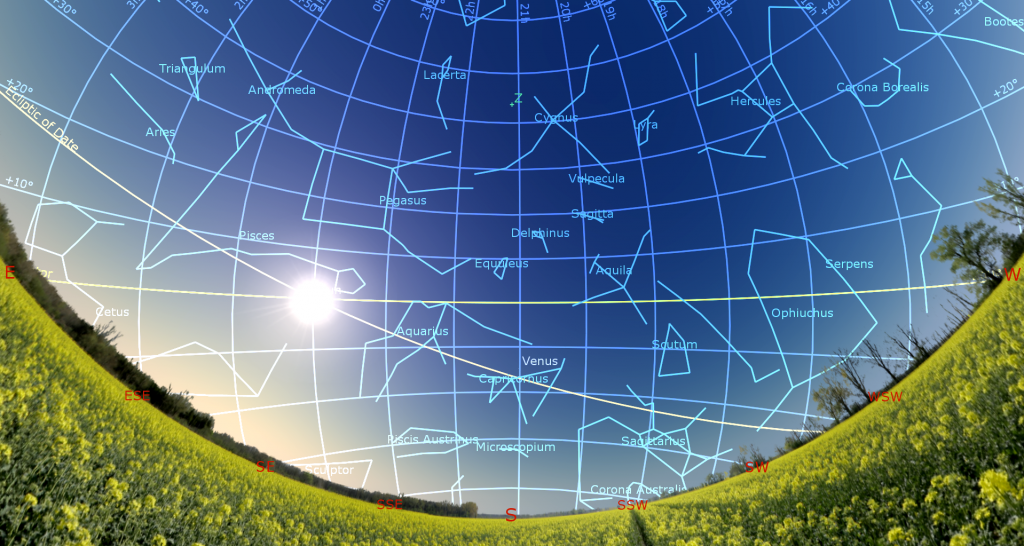
The period around the equinoxes also offer increased odds of seeing the aurorae at both high northern and southern latitudes. Just as two bar magnets lined up with their poles in the same direction repel one another strongly, the Earth’s magnetic field repels the sun’s field. At the equinoxes, the Earth’s axis is tilted neither towards nor away from the sun, so the two “magnets” aren’t as parallel, reducing Earth’s ability to repel the sun’s field – and the charged particles that trigger aurorae in our upper atmosphere. I wrote a more detailed post on this topic with diagrams here.
It seems highly likely that St. Patrick’s Day, now observed annually on March 17, arose after the early Christian Catholic church converted pre-existing Celtic celebrations already being observed at the equinox to a church feast day. It drifted away from the typical equinox date because of inaccuracies in the Julian calendar.
Persians will celebrate their New Year, called Nowruz or Norooz “New Day” on Sunday, March 20, 2022. It begins at the midnight hour occurring closest to the March equinox, as measured in Iran Standard time. The Persian calendar, which originated with the Babylonians, is based on the sun, but not the moon. I discussed this and other connections between world religions and astronomy during an Insider’s Guide to the Galaxy session on YouTube here.
Pointing at Polaris
If you missed last week’s information about Polaris, commonly known as the North Star, I posted it here.
Public Astro-Themed Events
Every Monday evening, York University’s Allan I. Carswell Observatory runs an online star party – broadcasting views from four telescopes/cameras, answering viewer questions, and taking requests! Details are here. Their in-person Wednesday night viewing has been converted to online via the observatory YouTube channel.
It’s March Break in Ontario!
On Monday afternoon, March 14 from 2 to 4 pm EDT, the David Dunlap Observatory from the comfort of your home with their family friendly Spring Break virtual programming! The DDO team will provide a tour of our Solar System and share fun stories about each planetary body in our cosmic neighbourhood. Participants will get the chance to paint and design their own planets with materials they have available to them at home: 8-10 Styrofoam balls or round objects, coloring materials (acrylic paint, markers, crayons, etc.), glue, and bristol board. Only one registration per household is required. More information is here and the registration link is here.
My free, family-friendly Insider’s Guide to the Galaxy webcasts with Samantha Jewett of RASC National returns on Tuesday, March 15 at 3:30 pm EDT, when we’ll broadcast live from Canada’s largest optical telescope at the David Dunlap Observatory, talking about the DDO and large telescopes. And – we’ll continue with our Messier Objects observing certificate program. You can find more details and the schedule of future sessions here.
On Tuesday afternoon, March 15 and Thursday afternoon, March 17 from noon to 1:30 pm EDT, join the David Dunlap Observatory team to learn about the sun and practice safe solar observing! In this interactive virtual session, participants will see live and pre-recorded telescope views of the solar surface, learn about our nearest star, and practice safe solar observing by making their own pinhole projector. Supplies needed (per participant): One large cereal box (or similar), Aluminum foil, One thumb tack or pin, tape, and scissors. Adults are required to help and supervise children too young to use sharp tools (scissors, tacks) alone. Only one registration per household is required. More information is here and the registration links are here (Tuesday) and here (Thursday).
On Wednesday evening, March 16 at 7:30 pm EDT, the RASC Toronto Centre will live stream their monthly Speakers Night meeting. This month will feature Chimira Andres, Planetary Geophysics PhD Student at York University and Science Communicator. Her talk is titled Exploring the Martian Cryosphere: A Treasure Map of Ice on Mars. Everyone is invited to watch the presentation live on the RASC Toronto Centre YouTube channel. Details are here.
Don’t forget to take advantage of the astronomy-themed YouTube videos posted by RASC Toronto Centre and RASC Canada.
Keep looking up, and enjoy the sky when you do. I love questions and requests. Send me some!